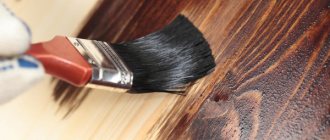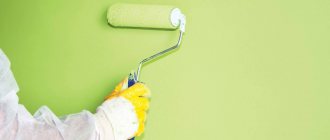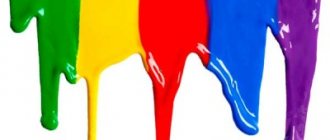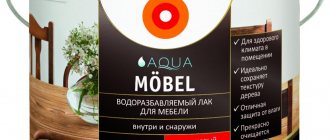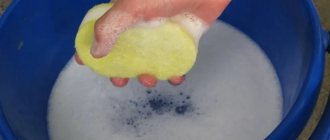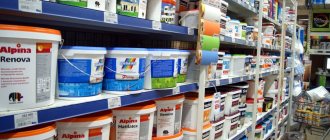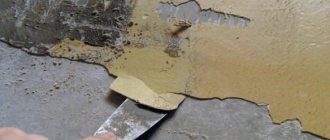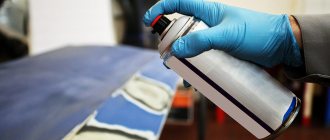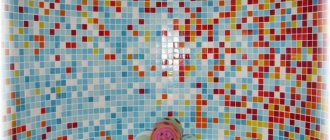Types of paints and varnishes
The composition of paints and varnishes includes binders, fillers, pigments, solvents/thinners and additives. In order to competently use paint and varnish materials during repairs, you need to know exactly their composition.
Main components
Oil paints based on drying oil.
All paints are divided according to the type of binder used and the type of solvent.
- The binder determines the main qualities of the paint, the service life of the coating and the speed of its drying
. There are 4 common types of binders used for paints and varnishes: alkyd and epoxy resins, oil-based (on drying oil), latex, acrylic polymers. - Solvent components are divided into solvents themselves and diluents
. The former reduce the fluidity and viscosity of the material. Thinners only reduce the viscosity of the paint. - To improve the characteristics of paints and varnishes, additives are added to their composition
: stabilizers, emulsifiers, fungicides, antiseptics, etc. - Special paints belong to a separate category
. These are anti-corrosion coatings, for example, Zinga electrically conductive paint. Analogs with antiseptic properties that protect the base from mold and rot. Compositions for removing small defects (irregularities, scratches, cracks), etc.
Oil and enamel compositions
The photo shows acrylic enamel.
Materials based on alkyd and acrylic resins include oil and enamel paints. They are suitable for painting metal, wood and plastered surfaces.
After drying, they are non-toxic, light and moisture resistant.
- Oil paints are produced on the basis of drying oil. White Spirit, gasoline, turpentine or solvent naphtha are used as diluents. The compositions are not expensive, but they take a long time (up to several days) to dry. The main disadvantage is that over time the coating turns yellow.
- Varnish is added to enamel compositions as a binder. It gives the coating gloss and aesthetics. The instructions recommend using such paints for external and internal finishing work on metal, wood, concrete, and plaster. Enamels are moisture and light resistant. They also have anti-corrosion resistance.
Emulsion and dispersion materials
Water-dispersed composition.
Such paints are diluted, but not soluble with water. In them, the binder and pigment particles are distributed in a liquid medium, creating a stable emulsion.
When the coating dries, it is not washed away by water.
- Emulsion compositions are economical, environmentally friendly and fire safe.
- They fit well on almost any substrate.
- They dry quickly and do not have a pungent odor.
Many people think that water-based and water-dispersion compositions are the same.
However, they are different.
- Matte emulsions wash off over time. The dispersions are waterproof and suitable for use in damp areas.
- Water-dispersion compositions are usually white; water-based analogues have a variety of colors.
- Dispersions cannot be used at temperatures below +5 degrees. However, with the addition of modifiers, they are thermally stable. Such, for example, are fire-retardant paints for metal Polistil.
- Such compositions are frost-resistant after they are completely dry.
- They are vapor permeable.
- Suitable for alkaline substrates (concrete, plaster).
- These paints are tinted very well.
- Resistant to ultraviolet radiation, retains its original color for a long time.
- They have the ability to repel water.
- They have high mechanical stability.
Options for applying water-based emulsion to oil-based materials
When it is decided to cover the old oil layer with a new one, it would be logical to use the same composition. Then there will be no conflict between the coatings. But there are nuances that stop the reuse of oil dye:
- it has a pungent odor that does not dissipate well;
- little varied color palette.
When compared with water-based paint, the second material has more advantages:
- environmentally friendly product, allows surfaces to breathe;
- coating service life is at least 12 years;
- no pungent odor;
- high drying speed;
- economical consumption.
What is the difficulty of applying
But the question of whether it is possible to paint water-based paint over oil-based paint is controversial among craftsmen. Disputes arise due to the fact that the solvent in the water-based emulsion is water. The paint adheres firmly to the surface if it saturates it. A contradictory situation arises: the oil layer in the form of a film repels water. When the water-based composition dries, it loses some of its water. But on an oil basis, the process occurs unevenly. In damaged areas, the new material will be absorbed. In places where the oil coating is preserved, the applied water-based paint will not adhere. Without preparing the entire area, the coloring will not be of high quality.
There are 3 options for applying a water-based layer to an oil surface:
- If the layer of oil paint is preserved in perfect condition, then the task comes down to removing the protective film, which repels water and prevents the water-based emulsion from penetrating deeper. Only after this the new CM will have adhesion to the base for a long period of time.
The surface is washed with detergents. They are washed off with clean liquid. After the walls have dried, they are coated with drying oil, which serves as the basis for water-based paint.
The second option for creating a base for painting: sanding the entire area (zero or one).
- If there are small defects, then treatment with a primer is recommended. It ensures the tenacity of the two compounds to each other, leveling problem areas on the walls. But you can also use putty for this.
Masters recommend primers: Parade Reanimator (452.00 rubles per 2.5 liters), Bindo Base (1269.00 rubles per 10 liters) or Glycoprim (1950.00 rubles per 5 kg). No surface preparation is required for their application and they dry quickly. After 60 minutes, CM is applied.
- But the strongest adhesion will be after the oil coating is completely removed. This is done in two ways.
- The wall will be clean after knocking off the old oil layer from it with a hammer drill or grinder. The process is long, labor-intensive and dusty.
- Special washes are used. For example, “Paint Destroyer B-52.” Under its influence, the oil base softens and is removed with a spatula. The integrity of the wall is maintained and there is no dust. But not all oil dyes can be washed off even after repeated processing. As a result, we have to resort to the mechanical method.
When the wall is clean, it is not yet time to paint. Preparatory measures are carried out: the entire surface is sanded, serious defects are puttied, sanding is carried out. Additional protection against fungus and mold is recommended - the application of antiseptic agents.
Conclusion: doubts about whether water-based emulsion will stick to oil-based paint disappear if the surface is carefully prepared. The best tenacity of the two compositions will be provided that the old layer is completely removed. The work is hard, but having completed it once, the base is prepared for any coating.
Differences in paints
Before you understand whether it is possible to paint products coated with acrylic with alkyd paint, you need to understand the compatibility of these enamels.
- Acrylic paint bases last longer on the surface. Alkyd enamels are not so durable. And if the product or surface is cleaned and primed before painting, the coating will remain for more than 20 years. Surfaces coated with alkyds become unusable a year after the first painting.
- Acrylic is indifferent to the effects of ultraviolet rays. Under direct sunlight, the enamel does not peel, does not turn yellow, and does not lose transparency. The Alcides cannot boast of this.
- But alkyd paints dry faster. Therefore, they are indispensable for quick coloring. Unlike competitors, which only need two days to dry completely, acrylics dry for a month.
- Acrylics take a long time to dry, but during this process a film is formed that is more resistant to mechanical damage. Other coatings do not differ in such properties.
- Alkyd substances have a wide variety of shades, which is not typical for acrylic paints. If choosing non-standard colors is important, it is better to choose acrylic enamels.
Details about acrylic paint
Acrylic paints are mainly used for wall and ceiling structures, and even for some decorative elements. They include the following components:
- polymer acrylic emulsion;
- some of the dyes;
- distilled water.
Let's look at how acrylic paint differs from other media and its advantages:
- The composition dries quite quickly. It hardens within half an hour after application, and reaches full strength in a couple of days;
- High quality, and, consequently, long service life;
- The presence of a film that performs a protective function against moisture, temperature and ultraviolet rays;
- As a difference, it is worth remembering the versatility of the material, which allows it to be used both for painting during the repair process and for decorative painting;
- Environmental safety, allowing active use in the interior space of homes;
- Ease of use, allowing use without additional equipment and professional workers.
The difference between acrylic paint and water-based and other compositions is its versatility, high quality and long service life. The painted surface becomes bright and saturated.
Painting rules or how not to make mistakes
When the surface is pre-prepared and well-dried, proceed to applying the desired shade of water emulsion on top. The entire procedure must be carried out carefully and slowly.
- We prepare the necessary material and equipment (brushes, paint tray, roller).
- Pour the paint into the tray and make sure that it is not too thick, otherwise it will be difficult to apply it to the surface.
- Make sure the direction of the brush is correct relative to the incident light. This will prevent the dye from leaving streaks, and the paint will in turn lie smoothly.
- Apply paint in several layers (at least three). If there was no sanding beforehand, then you should choose a thick paint consistency.
Removing old oil paint from wallsSource roomester.ru
Scraping old oil paint from wooden walls using special equipmentSource ecosystems.pro
How to apply?
Painting a ceiling using old paint is not difficult; anyone, even an inexperienced person, can do it with their own hands. After all stages of preparation, you need to start painting.
The best paint coating is considered to be three layers; in this case, you can be sure that there will be no streaks or streaks left on the surface. Before applying each layer, the roller must be carefully rolled out in a tray to get rid of excess paint; thanks to such manipulations, the possibility of smudges is eliminated. The first and last layers should be applied correctly perpendicular to the windows; this applies to all types of paint, including acrylic.
When painting, you should not make sudden movements; you must smoothly move the brush or roller along the ceiling, slowly, inspecting so that there are no unpainted areas left.
The next layer should be applied only to a dry surface, and there is no need to speed up the process in any way; the paint should dry naturally.
After applying the second layer of paint, it is advisable to exclude the possibility of exposure to direct ultraviolet rays, as well as the occurrence of drafts, which will help to avoid peeling of the coloring material from the base.
You can paint the ceiling with several types of tools. The most common are a paint brush and a foam roller; you can also apply paint using a spray gun, which is a regular spray gun. This device helps to carry out the painting process much faster, the main thing is that the paint consistency is appropriate.
When repainting the ceiling, it is better to use the same color or a similar shade, otherwise you will have to apply a large number of layers to completely paint over the previous coating and achieve the desired result.
Answers from experts
N:
rrr:
you can... but is it necessary?
Stepa:
On the contrary (in the sense of oil in emulsion), no. And the emulsion goes on well even without preparation (the first layer is a little worse). Well, if you sand an oil-painted wall and prime it with a good primer like “Dufa”, your paint will last happily ever after.
trickster:
maybe just a few layers. You can’t use nitro paint, it will peel off
Olga Smychenko:
You can if you use caparol matlatex or caparol malerit paint. But before that you need to prime it with Ceresit primer and let it dry for 12 hours.
Vita Marchenko:
It will be difficult to paint and then when washing the water emulsion will be downloaded
Olesya Chernova:
Anything is possible, it will be ok, that weekend we were painting the ceiling at the dacha. It turned out great, nothing was cut, just the dust was washed off the ceiling.
Svetlana Spiridonova:
No. And if you really need to, then peel off the old paint, prime it, then level the surface, sand it with fine sandpaper and only then paint. If you are leveling with a coarse putty material (Rotbant), then sand with coarse sandpaper (sandpaper). If you are leveling with a finishing putty (Vetonit LR+). That's fine sandpaper.
Maxim Prolygin:
If you take a facade emulsion, it sticks to almost anything.
Alexei:
Of course you can, go over it with fine sandpaper, then two layers of primer, and then paint it two or three times (depending on the quality of the paint) and that’s it.
Alexander Khvostantsev:
Of course it will - where will it go?
Korolev Yuri:
You just need to do the preparation and sand the paint with sandpaper, go through the primer and then paint it in several layers with water-based emulsion
Dmitriy Geshtalt:
When painting any surface, special attention should be paid to the compatibility of paint materials. Water-dispersion paints are poorly compatible with solvent-based enamels (MA, PF, NC). The use of water-dispersion paints in the interior and exterior is much more profitable and environmentally friendly than solvent-based enamels
On a façade, for example, water-dispersed paints last from 8 to 12 years, while PF enamel lasts only 3-5 years. In addition, water-based paints, unlike enamels, form a “breathable”, vapor-permeable coating
The use of water-dispersion paints in the interior and exterior is much more profitable and environmentally friendly than solvent-based enamels. On a façade, for example, water-dispersed paints last from 8 to 12 years, while PF enamel lasts only 3-5 years. In addition, water-based paints, unlike enamels, form a “breathable”, vapor-permeable coating.
Considering the above advantages of water-dispersion paints over enamels, it is not surprising that they are crowding out solvent-based products in the market of paints and varnishes. The consumer’s desire to use more environmentally friendly, cheaper and durable materials is understandable. But, unfortunately, it will not be possible to simply apply water-dispersion paint to a surface previously painted with PF enamel. The most radical method of solving the problem is to remove the old paint. With the help of “Paint Destroyer B-52” you can easily get rid of any putties and alkyd enamels without damaging the surface being cleaned.
Apply a 1-2 mm layer of “Paint Destroyer B-52”; after 30 minutes, remove the peeled paint with a spatula. If this is difficult to do, we recommend using acrylic “Special primer PARADE Reanimator G 40”, which is intended for priming various types of surfaces previously painted with alkyd or oil paints for further finishing with water-dispersed materials.
It is enough to thoroughly mix the ready-to-use PARADE Reanimator Special Primer, then apply it in one layer to the surface with a roller or brush. After 1 hour, the PARADE Reanimator Special Primer will dry, forming a translucent, slightly rough surface that is ready for painting with water-dispersed materials.
Surface is in good condition
A surface can be called almost ideal if:
- there are no cracks, swollen places or stains on it;
- it is completely level (you can measure it using a level).
Of course, in such cases it is not at all necessary to peel off the old layer. But the surface still needs some preparation. Namely, it needs to be washed: first treating it with a light solution with a non-aggressive detergent, and then with clean water. Painting should begin only after complete drying.
It is recommended to apply two coats. The water-based emulsion for the first layer should be liquid. You need to dilute it about 2 times stronger than usual. This layer will serve as a primer. When it dries, you can apply a second one - this time it has a normal consistency.
Experts point out that the old coating should be two to three shades lighter than the new one. If it is completely dark or very bright, but you want something more delicate, the old layer of paint will have to be removed.
Difference between acrylic and water-based paint
How do these materials differ from each other? A water-based composition is a large group of mixtures for which water is the solvent. The final properties of the product depend on the additives; they can be polymer or mineral.
Acrylic solution is a type of water-based emulsion. The composition of this mixture is: dye, polymer emulsion (in this case acrylic), distilled water and special additives to improve characteristics. Thus, a more modern composition with excellent qualities is obtained.
- Water-based paint is often associated with traditional paint that contains chalk or slaked lime. Basically, such mixtures are prepared independently with the addition of PVA.
- Differences in GOST. This regulatory document reflects all the technical characteristics of the material. Under number 28196-89 there is water-dispersion paint, which often has a more popular name - water-based emulsion. Such confusion arises due to the fact that the expansion of GOST occurs very slowly. The characteristics specified in 1989 no longer correspond to the range of products present on the market.
Technical characteristics of acrylic compositions
Acrylic paint has properties that distinguish it from classical materials:
- Good viscosity. The solution does not flow off the surface, which ensures uniform distribution and quick fixation.
- Light weight. This eliminates the overall load even on a fragile base, such as drywall.
- Good hiding power.
The composition is applied at temperatures above +15 and humidity 65–70%. Other specifications vary by manufacturer.
The difference between acrylic paint and water-based paint
Let's look at the difference between water-based paint and acrylic paint. Everything is extremely simple. Water-based compositions are a broader type, divided into several types.
Acrylic composition is a type of water-based paint. Thanks to the additional components included in the mixture, a more advanced paint is obtained, differing from the usual water-based mixture in more practical qualities. It is also worth noting that the technical characteristics of this composition are more positive.
Acrylic water-based compositions are particularly resistant to various influences and cannot be washed off with water. This good characteristic of the material allows it to be used even outdoors.
The only significant drawback of an acrylic-based mixture is its high cost. But it is also offset by the cost-effectiveness of the application process.
Ways to solve the problem - additional tips
It follows from this that the evenness of the oil coating directly depends on the conditions and time of operation of the room. The quality of the original paint, naturally, also affects the subsequent application process. Often the wall looks like a washboard. If you paint directly on such a surface, you will get a terrible result.
How to avoid this situation? You can try the following three methods that are cost-effective for minor home renovations.
- Matting. If the oil surface is preserved in good condition, matting will allow you to remove the glossy surface (that very film), which creates problems with the penetration of the water base. Expected result: the paint should be able to adhere to the wall, as the obstructive layer will be eliminated. The matting process is primitive. The wall is washed and dried with a construction hairdryer, after which it is worth using drying oil to coat the entire surface, and a layer of water-based emulsion can be applied on top. The mechanical type of matting looks like this: the surface is rubbed using fine sandpaper. In this case, reliability is increased, the gloss will be removed with guarantee.
- Padding. Suitable for already worn surfaces. If you can cover some parts of the wall with soil, where the crumbling is most obvious, you will be able to level out the failures. Unfortunately, it is almost impossible to cover a wall with major damage with putty and level it. Modern specialized soils should be used, which are abundantly available on the building materials market. Ease of use and drying speed make it possible to use such materials even with a low degree of preparation of the working surface. The drying speed of modern primers allows painting within an hour after application. This method is beneficial for large gaps, often obtained when painting with oil paint, and will also allow the liquid of the water-based coating to be well absorbed.
- Delete. The best in terms of efficiency, but the most labor-intensive process of carrying out the procedure in question. Complete removal of oil paint down to the concrete base of the wall allows for better results when applying another paint to the surface. Let's look at how to do this process as quickly as possible. You can knock off the paint by hand, but it is better to find an opportunity to use a power tool. Both a grinder and a drill with specialized attachments will do. You can knock off the paint directly with a hammer drill. The process will take a long time to occur when using conventional mechanical tools; carry out this work only if there is a complete absence of alternatives and in conditions of a small volume of work in the room. The end result is a completely clean wall.
Suppose I don't remove the old paint
Let's look at how to paint with water-based paint over oil paint. Note that the quality of the final coating will depend on the quality of the old one. If the oil paint still begins to peel off the surface, it is better to remove it completely.
Before work, the surface must be completely cleaned of dirt and degreased. A primer is not necessary when working on oil-based paint, but it won’t do any harm.
Oil paint has water-repellent properties. Since water is the main binding component of water-based paint, it will not adhere well to the surface, especially if you forgot to degrease it.
You can improve the adhesion of water-based paint to a surface painted with oil-based compounds in the following ways:
- Matting. The new paint will adhere perfectly to a matte (finely porous) surface. Matting can be done by covering the surface with drying oil or mechanically. On the one hand, the first one is simpler, but drying oil has a pungent odor and not everyone wants to work with it. The mechanical method involves treating the surface with fine sandpaper (zero sandpaper).
- Using a primer. There are special primers that work well on glossy surfaces. They should be used. In addition to the fact that the primer will ensure good adhesion of the water-based paint to the surface, it will also eliminate minor surface defects (for example, pinpoint bald spots in an old coating).
- Finally, the last option is to remove the old coating. Please note that immediately after removing the old coating, you cannot apply a new one. The wall must be cleaned of dust, washed and degreased.
How to calculate consumption?
Before purchasing, it is necessary not only to decide on the type and color of the ceiling paint, but also to calculate the required volume, which is determined by its consumption. The required quantity depends on the size of the room, which determines the ceiling area. Usually, all the necessary information for calculating the color composition is on the packaging, so you should definitely read the instructions.
In general figures, you can focus on the following calculations. The average consumption of water-dispersed paint when finishing ceilings is about 100 – 120 g/m2. Depending on the surface, at least two or three coats will be necessary to achieve a good, uniform finish. The material consumption is approximately the same whether using a roller or using a brush.
If we take into account the lack of experience and the inability to rub paint professionally, then the average consumption will be 300 g/m2
Having chosen the required type of water-based paint, you can read information on the packaging about whether it requires dilution. If manufacturers recommend diluting the purchased material, then water can be added to the required amount of paint; as a rule, no more than 5-10% is required. It is best to use the prepared volume immediately; do not let it thicken again. The best option is considered to be diluting the paint to the state of liquid cream.
It happens that the material does not require dilution; it is enough to just mix it thoroughly. Such manipulations will be enough if you plan to paint the ceiling in one layer; in such situations, the paint should be a little thicker.
For the entire surface of the ceiling, you should purchase paint from the same manufacturer, the same brand. This requirement guarantees a uniform, monochromatic coating.
Is it possible or not?
In fact, it is possible to apply a coloring composition to oil paint in cases where the surface will not be used intensively. For example, you can cover the ceiling in this way, but it is better to abandon this idea regarding the walls in the hallway. The fact is that after constant friction of the outerwear on the coating, it begins to wear off, and stains of the previous facing layer will begin to appear.
Using a brush to paint walls with water emulsion Source gidpokraske.ru
Water-based paint
It is a generalized concept of paint and varnish products, divided into various subtypes. Contains pigments, special-purpose polymer substances, and water. Some varieties contain acrylic and silicone resins. The consistency required for painting the surface is obtained using solvents. The exact paint consumption per square meter depends on the type of surface being painted.
Advantages
Water-based paint is absolutely safe for humans, does not emit toxic fumes into the environment, and also:
- has no odor after drying;
- has an affordable price;
- simple and easy to apply.
Painting can be done using a roller or a ball-type brush. To obtain the desired shade, coloring pigments are added to the paint. The paint and varnish material is ideal for performing interior finishing work at temperatures from 5 degrees above zero. Drying quickly, it allows you to apply a new coat almost immediately after the first.
Varieties
The following types of water-based paint are available: mineral, silicate, silicone and acrylic. Each differs in composition and scope of application. The most expensive type is silicone, which fits and holds perfectly. The most affordable is water-based mineral paint, the main component of which is either cement or slaked lime. The advantage is that it perfectly paints any surface, but does not have a long service life due to its high susceptibility to negative external factors. The specific properties of the paint and varnish coating largely depend on the composition and subtype. Acrylic, in fact, is a type of water-based one. Its cost is in the average price range, and its scope is quite wide. It is used for painting plastered, brick and wooden surfaces.
Paint selection
Currently, for painting ceilings, compositions are used that are presented in a huge range by manufacturers of paints and varnishes. Each type has its own characteristics and has a number of advantages and disadvantages.
To paint the ceiling surface, do not use oil paint. The best option is water-based, water-emulsion, or, as they are also called, water-dispersion paints.
Experts recommend using this type of paint to decorate ceilings in residential premises, because its main characteristics include:
- no pungent odor;
- absolute non-toxicity;
- good adhesion with most building materials;
- Possibility of application on old paint;
- practicality in use.
The most popular types of water-dispersion paints are:
- Latex - has a good level of coverage and density, does not wash off after drying, the surface can be wet cleaned. In most cases, one coat is sufficient.
- Silicate is a good option for exterior finishing of buildings. This type of paint is more expensive than its analogues, since it is based on liquid glass. As a rule, this coating is used for profile finishing of various surfaces in warehouses and production facilities. Perfectly covers concrete or stone surfaces.
- Acrylic is the most versatile paint, adapted to various surfaces. This substance can hide minor surface imperfections, and textured paint can remove minor cracks or potholes. The acrylic coating dries quickly enough and does not change color during use. Has a certain level of resistance to direct sunlight. The disadvantage is sensitivity to moisture. The color palette of acrylic paints is huge. All shades can have a glossy or matte effect. A matte surface can visually increase the height of the ceiling and help hide some defects. Gloss is convenient for use when painting large areas; it requires a perfectly flat surface.
- Silicone paint creates a beautiful finish that is washable. This type of paint is suitable for covering surfaces in rooms with high humidity and sudden temperature changes.
Each type of paint can be diluted with water if necessary to give the required consistency. With the help of tinting pigments, you can get any desired shade; to do this, just add the desired amount of dye to the white composition.
Tile
Is it possible to paint old tiles?
Yes - provided that it is not glazed. No paint will adhere strongly enough to glass-like glaze.
Solutions
After cleaning from lime and other deposits, the tiles can be painted without prior priming. In this case, you will have to use wear-resistant, highly adhesive paints based on urethane or epoxy. It is acceptable to use acrylic-latex rubber paints: at a moderate cost, they, like the two types of dyes mentioned above, will provide complete waterproofing of the surface.
Two-component epoxy paint.
Technology
How to do the work of preparing and painting tiles yourself?
- To remove deposits, it is better to use acidic agents - Sillit, solutions of hydrochloric or oxalic acids. The product is applied to the surface and washed off after 10-20 minutes. If necessary, processing is repeated several times.
Oxalic acid is an effective means for removing lime deposits.
- Two-component dyes are mixed with a hardener immediately before use.
- The wall and plumbing adjacent to the tile are protected with masking tape.
- The paint is applied with a brush or roller in one or two layers.
The theory about the correct choice of dye
The painting will be of high quality and the paint layer will adhere firmly to the surface with the old CM layer if there is good adhesion between the compounds. To achieve the goal, the following actions are taken:
- Before applying a new dye, the old coating is completely removed, and the surface is treated with special materials.
- The adhesion will be good if a composition similar to what was used before is chosen for applying the new coating. Their identical structure allows, to some extent, to simplify the work, which will save time. This is felt when painting a large surface area.
Acrylic copolymer based product
The acrylate binder in these paints can have a varied composition and contain copolymers - additional chains that modify quality parameters. The number of available copolymers is extensive and covers most needs for materials with special properties.
The latex component improves the characteristics of acrylic, making the paint more popular, although more expensive.
Features and Specifications
Common positive properties inherent in both acrylic and latex paints include:
- strength and durability of the resulting polymer layer;
- rich colors that do not lose brightness over time;
- stability under the influence of ultraviolet radiation from the sun;
- water base, which ensures the non-toxicity of the color mixture and the absence of unpleasant odors during operation.
Latex additives modify the strength and visual properties of acrylic paints, giving them the following characteristics:
- high elasticity - latex paints can be applied over embossed walls and wallpaper, since they follow any curves of the base well;
- aesthetics - rubber additives give the surface a visual silkiness;
- resistance to abrasion and water. Most latex paints are suitable for intensive washing, which cannot be said about ordinary acrylate compositions.
Product types
There is no strict classification of mixtures with rubber additives, although manufacturers usually indicate their properties and purpose in the information on the packaging. The most common types of paints are:
- matte, semi-matte and glossy - used for various purposes and surfaces. The glossy mixture is applied only to perfectly smooth walls or ceilings, since even minor irregularities and defects will become clearly visible under the gloss. Matte paint is better suited for less level walls and floors, while semi-matte acrylic copolymer latex paint has intermediate properties;
- facade, for walls, ceilings or floors - determine the main purpose of the paint. Although a significant part of the compositions are universal and can be used for identical purposes, it is better to follow the manufacturer's advice and apply the paint to suitable surfaces. And yet, the question often arises as to whether acrylic or silicone facade paint is better;
- washable, impact-resistant and moisture-resistant - characterize the main parameters of the coating after evaporation of the thinner (water). The properties of latex acrylic paints are similar to each other, so even mid-price compositions will provide high quality painted layers.
Material cost
The minimum price for acrylic latex paint is approximately 200 rubles/l. The cheapest products are from little-known companies. Sometimes ordinary acrylic dispersion is sold under the guise of latex paint, and the word “latex” appears only in the inscription on the label.
In order not to make a mistake with your choice, you should purchase products from more well-known manufacturers. The highest quality compositions can cost up to 1000 rubles/l or more, fully performing the functions assigned to rubber decorative coatings.
Below you will find a useful video on how to treat walls using acrylic latex paint Snezhka, and also learn about the advantages of this type of material:
Next we will talk about whether acrylic and latex paints can be mixed.
Applying primer
Before applying the primer, you need to follow a technology that includes the following work: – the glossy coating should be given a rougher structure, for this purpose rough grinding is used; – peeling old paint must be removed using a scraper, brush or other tool; – the prepared surface must be degreased. When priming, you should take into account the specifics of working with this material. The main requirement is a homogeneous structure. Before painting, the primer must be thoroughly mixed. If the mixture is too thick, it should be diluted with plain water. Allowable content is up to 10% of the total volume. Surface treatment with the finished composition can be done with a roller. With this tool, the soil is distributed more evenly, without smudges. When working with materials, builders and finishers recommend treating the surface from the bottom up. At the same time, there should not be too much solution on the roller or brush. This will prevent the occurrence of leaks. If you do not follow this, the finishing coating will lie unevenly, and defects in the work will be visible. A roller is a convenient tool for processing large areas. A brush is suitable for priming awkward surfaces or too small parts. A good result can only be achieved with the integrated use of tools. The primer will work well on acrylic paint, water-based paint, or oil composition; for this you just need to follow the technology.
Preparing the base
One of the stages of working with soil is preparing the foundation. It is produced in the following order. It is necessary: – remove a layer of old paint using a scraper, brush, while capturing 5-10 cm of the surface from which the paint is difficult to scrape off; – clean the surface that will be painted from dust, soot, dirt using a sponge soaked in water and a suitable detergent; – treat the prepared area with soil; – apply putty to level the surface; – sand the area with fine-grained sandpaper after complete drying. Is it possible to subsequently use water-based paint applied to the primer as the basis for another coating? Preparation is done in the same way.
Pay attention to: How to dye a down jacket at home
Padding
It is necessary to adhere to priming technology, since this is a process on the correct implementation of which the strength and durability of the new paint coating depends. Can a primer be applied to water-based paint? Most manufacturers indicate that their products are intended for such work. Before starting the procedure, you need to make sure that the solution is homogeneous, fairly liquid, but not too much. To do this, the soil is thoroughly stirred immediately before working with it. Then it can be used for its intended purpose. For application, use a roller and brushes. Hard-to-reach surfaces and small elements can be passed with a brush. Large areas are treated with a roller. As necessary, it is moistened in the priming solution, and to prevent drips, it is squeezed well on a painting tray. To avoid the formation of streaks, the soil must be thoroughly rubbed into a fairly thin layer. After the first treatment, the second should be carried out. This is a necessary condition for obtaining good adhesion. Secondary primer treatment is carried out immediately after the already applied layer has dried. When carrying out work in a temperature and humidity regime favorable for repair (20-23 °C, 70-80%!), the break between stages will be about an hour.
Can paint (paint materials) be applied to the primer after this? When the second layer has dried, you can begin the planned types of finishing work.
Important! Follow safety precautions! Although the primer is not a high-risk paintwork material, you need to work with it with extreme caution. To do this, it is recommended to work with gloves and special clothing. What should you do if the composition accidentally gets on your mucous membranes, especially your eyes? They should be rinsed with plenty of running water for 10-15 minutes. If you feel discomfort (itching, burning), you should consult a doctor.
Types of paints and varnishes
The composition of paints and varnishes includes binders, fillers, pigments, solvents/thinners and additives. In order to competently use paint and varnish materials during repairs, you need to know exactly their composition.
Main components
Oil paints based on drying oil.
All paints are divided according to the type of binder used and the type of solvent.
- The binder determines the main qualities of the paint, the service life of the coating and the speed of its drying. There are 4 common types of binders used for paints and varnishes: alkyd and epoxy resins, oil-based (on drying oil), latex, acrylic polymers.
- Solvent components are divided into solvents themselves and diluents. The former reduce the fluidity and viscosity of the material. Thinners only reduce the viscosity of the paint.
- To improve the characteristics of paints and varnishes, additives are added to their composition: stabilizers, emulsifiers, fungicides, antiseptics, etc.
- Special paints belong to a separate category. These are anti-corrosion coatings, for example, Zinga electrically conductive paint. Analogs with antiseptic properties that protect the base from mold and rot. Compositions for removing small defects (irregularities, scratches, cracks), etc.
Oil and enamel compositions
The photo shows acrylic enamel.
Materials based on alkyd and acrylic resins include oil and enamel paints. They are suitable for painting metal, wood and plastered surfaces.
After drying, they are non-toxic, light and moisture resistant.
- Oil paints are produced on the basis of drying oil. White Spirit, gasoline, turpentine or solvent naphtha are used as diluents. The compositions are not expensive, but they take a long time (up to several days) to dry. The main disadvantage is that the coating turns yellow over time.
- Varnish is added to enamel compositions as a binder. It gives the coating gloss and aesthetics. The instructions recommend using such paints for external and internal finishing work on metal, wood, concrete, and plaster. Enamels are moisture and light resistant. They also have anti-corrosion resistance.
Emulsion and dispersion materials
Such paints are diluted, but not soluble with water. In them, the binder and pigment particles are distributed in a liquid medium, creating a stable emulsion.
When the coating dries, it is not washed away by water.
- Emulsion compositions are economical, environmentally friendly and fire safe.
- They fit well on almost any substrate.
- They dry quickly and do not have a pungent odor.
Many people think that water-based and water-dispersion compositions are the same.
However, they are different.
- Matte emulsions wash off over time. The dispersions are waterproof and suitable for use in damp areas.
- Water-dispersion compositions are usually white; water-based analogues have a variety of colors.
- Dispersions cannot be used at temperatures below +5 degrees. However, with the addition of modifiers, they are thermally stable. Such, for example, are fire-retardant paints for metal Polistil.
Note! The best analogues of water-based paints are based on acrylic resins and polymers. They have high elasticity and strength
- Such compositions are frost-resistant after they are completely dry.
- They are vapor permeable.
- Suitable for alkaline substrates (concrete, plaster).
- These paints are tinted very well.
- Resistant to ultraviolet radiation, retains its original color for a long time.
- They have the ability to repel water.
- They have high mechanical stability.
How to apply paint primer
Professional builders will not carry out finishing work without prior preparation. A primer for walls for painting, wallpapering, or putty is simply necessary.
Some customers, having read the preliminary estimate, try to challenge this position.
Professionals will definitely insist on carrying out this work and explain their importance for quality repairs.
What functions does the primer perform?
Before you begin the process of priming the walls, you need to decide on a number of factors.
The main ones:
- what materials the wall is made of;
- condition of the coating;
- stages of its finishing;
- what will be the finishing?
It should be noted right away that a primer for walls before painting is required, even if the wall, at first glance, has no visible flaws. If we are talking about secondary repairs, then a number of preparatory stages of preparation are required.
There is a term “adhesion” - the ability of materials to adhere to each other.
If the paint does not lie tightly, then over time it will begin to peel off in certain places, even if outwardly everything looks perfect after the repair.
This can be facilitated by changes in humidity and temperature, mechanical stress, the presence of third-party substances in deep layers, for example, oil stains, and other factors.
Primer before painting will prevent peeling. Adhesion occurs due to the polymer composition of the mixtures.
Under certain negative conditions, in particular poor ventilation of rooms or improper insulation of walls, excess moisture accumulates in them. This provokes the appearance of fungus.
One of the components of the composition of primer mixtures are additives (fungicides) that interfere with this process.
What is the difficulty of applying
The basis of the water-based emulsion is water, in order to obtain reliable fixation, the surface is impregnated with the water base, and after drying it evaporates. However, the oil base does not allow water to penetrate into the wall; the drying process of the water-based coating involves evaporation of moisture; on such a coating it will not occur evenly, and accordingly the paint on top will come off. In those areas where the layer of oil composition has come off, adhesion will be good, in the rest it will be low.
There are three ways to solve the problem:
- From a well-adhering coating, the film layer is removed, which makes impregnation difficult. First, the entire surface is washed with detergents, then they are washed off with clean water. Next, drying oil is applied to the dry wall; it will create an intermediate layer between the paints;
- For a wall or ceiling with small cracks, use putty to eliminate them, or apply a primer mixture;
- The best option remains to remove the old finish completely. It is carried out using a hammer drill or grinder. The equipment is used to remove the previous coating, the process takes a lot of time and requires a lot of effort. Or they use specialized washing solutions; they soften the composition, after which the finish can be removed with a spatula. They cannot cope in all cases, so they switch to a mechanical method.
The best option remains to remove the old finish completely.
Are oil-based and water-based emulsion paints compatible?
Emulsion paint is dissolved with water, so it will slide off the oil coating. It is generally accepted that both of these compositions are incompatible. Accordingly, before applying the water-based emulsion to the gloss of the previous layer, it is necessary to ensure permeability into the pores. Otherwise, it will be impossible to achieve the desired effect.
Since the liquid is repelled, it cannot be absorbed into the oil base, therefore applying these compositions to each other without prior preparation is a waste of time.
Oil paint is incompatible with water-based emulsion Source stroymix67.ru
Painting walls with water-based emulsion using a roller Source stroymix67.ru
On a note! There are places on the old coating where the paint is well preserved. The water emulsion will not be able to adhere to this fragment: it will simply drain.
Is it possible or not?
So is it possible to apply a water emulsion to oil paint, and which one is better? And yet, the answer is: you can use water-based emulsion, but under certain conditions. First of all, it is worth considering the question of the intensity of use of the place that is to be painted with water-based oil paint, and then answer the question - can it be painted or not. If this is the ceiling or the upper part of the wall in the living room, then you can, without hesitation, choose the desired color and, after a little preliminary preparation, paint it with enamel.
If you are planning to paint a cramped hallway with protruding corners with water-based paint over an oil-based coating, then this idea will seem promising at first, but after a couple of weeks of use it will become clear that this was a bad idea. Even with very high-quality preparation and compliance with all application rules, with frequent intense friction, water-based paint will quickly rub off from a smooth oil coating.
Condition 1. Painting with water-based paint over previously applied oil paint is allowed if the area to be painted will not be subject to intensive use.
Surface preparation
Carefully inspect the oil finish that is to be repainted. Typically the coloring is from the late 80's or much earlier. In the 90s, water-based painting was already widely used. Almost all surfaces were painted using water emulsion.
Oil-painted surfaces from those early years are distinguished by enviable durability; it is not so easy to “tear off” such a coating from a wall or other surface, unless together with plaster. Even “killer” chemical solvents are sometimes powerless in the fight. With water emulsion everything is much simpler. Here primer manufacturers came to the rescue of home-grown finishers.
Coating oil paint with the simplest acrylic primer will create a slight roughness on a smooth surface, allowing the water-soluble coloring composition to “catch” on the slippery surface.
Manufacturers went even further by releasing a special primer composition for old paint. It is designed for preliminary preparation of smooth oily surfaces and is sold in any large construction supermarket.
Better surface preparation can be achieved by pre-grinding with fine emery cloth. For this “procedure” it is better to use a grinder with a grinding disc or a drill with a special attachment.
It is unlikely that it will be possible to sand a large area by hand. The big advantage of this method is that unevenness, roughness and smudges of the old oil coating are simultaneously removed. The downside is that it's long and dusty. Sanding will not eliminate the additional work of thorough cleaning and priming, but will significantly improve the adhesion of primers and water-based paints to old oil paint.
On video: preparing walls for painting.

